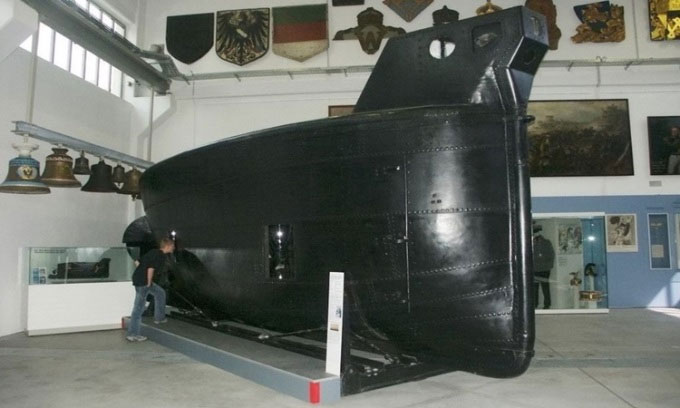Brandtaucher - The oldest surviving submarine in the world
Although it sank on its first attempt, the Brandtaucher submarine is an exciting testament to the early achievements of military technology and underwater navigation.
At the German Military History Museum in Dresden, there is a large iron submarine in the exhibition room. Manufactured in 1850, the pioneering ship Brandtaucher was the first German submarine built and the oldest surviving submarine in the world, according to Amusing Planet .

Brandtaucher submarine in the museum gallery. (Photo: Jan Rehschuh/Wikimedia Commons).
The Brandtaucher was designed by Wilhelm Bauer , a German engineer born in Dillingen in the Kingdom of Bavaria. Initially trained as a woodturner, Bauer eventually succeeded his father as a sergeant in the Bavarian cavalry regiment and joined the army. As an artillery engineer during the German-Danish War (1848 - 1852), Bauer witnessed how easily the American navy surrounded the Prussian coast. This experience inspired him to develop a submarine that could break the siege.
Submarines were not a new idea at that time. Among the first successful submarine models was one designed by Dutch engineer and inventor Cornelius Drebbel for King James I of England in 1620. It is unclear how much Wilhelm Bauer was inspired by his predecessors. responsibility. However, he began studying shipbuilding and hydraulics. While stationed in Jutland, Bauer observed the natural movements of seals and used them as a model to develop the design. In fact, the shape of his ship resembled a plump seal, earning it the nickname "iron seal".
Bauer returned to Bavaria in 1849 and presented his invention to a military commission, but they dismissed it. Undeterred, he went to North Germany and joined the Schleswig-Holstein army when they expressed interest in the project and asked him to develop it further and build a version. Bauer created a working version of the submarine, but the military refused to provide funding to make it a reality, forcing Bauer to raise funding from private sources. He gathered some money and began manufacturing ships with engineer August Howaldt.
However, due to lack of funding, Bauer and Howaldt had to make some important modifications to the original design such as reducing the ship's wall thickness and removing ballast tanks. Instead, water is contained in the bottom of the hull, below the main deck, and moves relatively freely in this area when the ship changes direction. This design flaw resulted in poor balance, which likely contributed to the ship's failure.
The Brandtaucher submarine is 8.5m long and weighs about 31,751kg. The ship operates with two sailors turning the wheel with their hands and feet. A third person sits at the rear of the submarine and operates the rudder and other control equipment. The Brandtaucher was designed to attack enemy ships. The ship would dive under the target's hull, where the captain would reach through a pair of rubber gloves attached to a hole in the hull and attach himself to the enemy ship.
On February 1, 1851, a performance was held in the port of Kiel. Inside the submarine were Bauer, carpenter Friedrich Witt and blacksmith Wilhelm Thomsen. The first few minutes went smoothly, but as Bauer reached the deepest part of the harbor to dive, the hull began to leak and could not withstand the water pressure. While the submersible began to flood, it slowly sank to the bottom of the harbor. Bauer and his companions waited tensely for six hours until the water had penetrated enough to equalize the pressure inside the sunken ship. This allowed the submarine's hatch to be opened and the three sailors to rise to the surface. The wreck of the Brandtaucher was salvaged in 1887 and is now on display at the military history museum in Dresden.
Bauer went on to build a second submersible, Seeteufel (Sea Devil), for Tsar Alexander II of Russia. Learning from previous experience with Brandtaucher, Bauer fixed the problem with the first design. The Seeteufel is much larger and more advanced, making 133 successful dives within 4 months. However, during the 134th dive, the submarine got stuck on the sand on the seabed. By pumping out all the water in the cylindrical tank, the crew raised the submarine high enough so that the ship's lid was above the water. The entire crew including Bauer was rescued but the submersible sank to the bottom of the sea. A miniature model of the Sea Devil is on display at the Deutsches Museum in Munich.
- 17 submarine and one-man submarine surprises you
- The oldest condom in the world
- HMS Artful - World's largest nuclear submarine
- The historical secret of the world's first submarine
- Komsomolet submarine: From Soviet pride to radioactive leak tragedy
- 111-year-old grandfather reached Guinness world record
- The Nereus submarine exploded at a depth of 10,000m
- 14 oldest ancient artifacts in the world
- New personal submarine
- The oldest man in the world died, aged 112 years
- German submarine explosion: Mysteriously challenging the maritime industry for nearly 100 years
- 10 oldest antiquities in the world
 'Fine laughs' - Scary and painful torture in ancient times
'Fine laughs' - Scary and painful torture in ancient times The sequence of numbers 142857 of the Egyptian pyramids is known as the strangest number in the world - Why?
The sequence of numbers 142857 of the Egyptian pyramids is known as the strangest number in the world - Why? History of the iron
History of the iron What is alum?
What is alum?